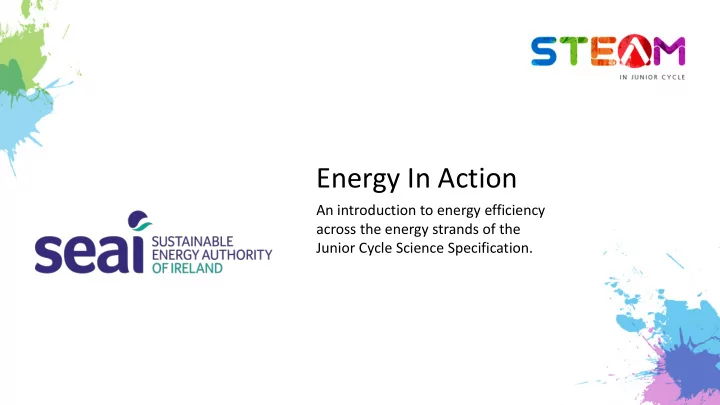

Energy In Action An introduction to energy efficiency across the energy strands of the Junior Cycle Science Specification.
Learning Outcomes PW 7 – Design , build and test a device that transforms energy from one form to another in order to perform a function; describe the energy changes and ways of improving efficiency PW6 –Explain energy conservation and analyse processes in terms of energy changes and dissipation NoS 10 – Appreciate the role of science in society ; and its personal, social and global importance; and how society influences scientific research.
STE(A)M boxes Look inside your STE(A)M box Construct a free standing tower that measures exactly 15cm high You don’t have to use all of the contents in the box You have access to a ruler and scissors if needed Draw 2 design ideas of your tower and then merge ideas in your group
Number of marshmallows & toothpicks used 5 4.5 4.4 4.3 4.5 4 3.5 3.5 QUANTITY USED 2.8 3 2.5 2.4 2.5 1.8 2 1.5 1 0.5 0 Team 1 Team 2 Team 3 Team 4 Team 5 Toothpicks Marshmallows
Definitions With energy efficiency , you don't have to sacrifice comfort to save energy Energy conservation involves a change in behaviour to save energy. Examples?
Mobile Challenge Look through contents of your STE(A)M box. Construct a mobile vehicle that can travel, horizontally, on a flat track – it must be self propelled. Before you make, draw two variations of your design and discuss in your group. You can use scissors and sellotape if needed. Not all contents need to be used!
SKETCH – DESIGN PROCESS
Discussion What propelled your vehicle? What were the energy conversions taking place? Were all the energy conversions useful?
Think about…Discuss..Write down.. If we were to replace the balloon with a hairdryer as a propeller what energy conversions are now taking place throughout the system? Are all energy conversions here working as useful energy within the system? Where is energy being changed into another form that is not useful?
For you to do… Test your vehicle – how long does it take to travel 2m? How could you make this a more precise measurement ? The Kinetic energy of your vehicle is calculated as follows: ½ x mass x velocity 2 This is the useful energy output. You may not change the mass of your vehicle but can you change its’ design to make it more efficient? i.e. increase its useful energy output.
Energy Conversion and Dissipation Did all vehicles get the same input of power from the hair dryer? Did they all travel the same distance? Was all the energy converted into useful Kinetic Energy?
Dissipation of Energy In most systems some energy is- dissipated that is it is converted into forms which are not useful and which cannot be recovered.
DISCUSS AND DECIDE…. If we were to race all the vehicles over 2 metres could we say that the winning vehicle was the most efficient?
Representing energy changes and dissipation Sankey Diagrams These give a visual of input and output energy. Width represents total energy, length doesn’t matter
Activities on Sankey Diagrams • Activities for Junior Cycle students • Download from www.seai.ie/teaching-sustainability/post-primary- school/energy-in-action/
Lets have a go
Activity on Electric Vehicles • Activities for Junior Cycle students • Download from www.seai.ie/teaching-sustainability/post-primary- school/energy-in-action/
What is our role as Educators in reducing global demand for energy? Discuss 5 things in your school or at home that use energy – heat, electrical etc. State the energy conversions involved. How can you calculate the % efficiency of 2 devices? Record ways of increasing the efficiency of the 2 devices.
Abstract for Winners 2017 : Raising awareness of energy ratings for household appliances, among adults in their community. Proposal forms to be submitted by end November 2017 with: - Team details - school, students, contact details, topic choice - Researching your topic - How? Where? When? Who? - Who is your target audience? Peers, Children, Adults
Activities for Junior Cycle www.seai.ie/teaching-sustainability/post-primary-school/energy-in-action/
Recommend
More recommend